Scutellaria barbata, the barbed skullcap, is a species of flowering plant in the mint family, Lamiaceae. It is native to Asia.
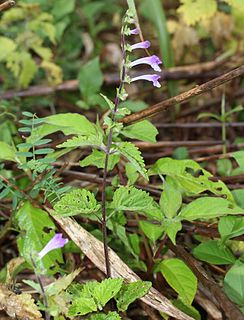
Scutellaria is a genus of flowering plants in the mint family, Lamiaceae. They are known commonly as skullcaps. The generic name is derived from the Latin scutella, meaning "a small dish, tray or platter", or "little dish", referring to the shape of the calyx. The common name alludes to the resemblance of the same structure to "miniature medieval helmets". The genus has a subcosmopolitan distribution, with species occurring nearly worldwide, mainly in temperate regions.

Scutellaria costaricana is a species of flowering plant in the mint family, Lamiaceae, that is native to Costa Rica and Panama. It is commonly known scarlet skullcap or Costa Rican skullcap and is a popular tropical houseplant.

Scutellaria baicalensis, with the common name Baikal skullcap or Chinese skullcap, is a species of flowering plant in the Lamiaceae family.

Scutellaria lateriflora, known commonly as blue skullcap, mad dog skullcap, and side-flowering skullcap, is a hardy perennial herb of the mint family, Lamiaceae, native to North America.
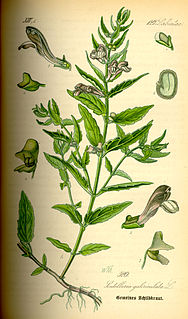
Scutellaria galericulata, the common skullcap, marsh skullcap or hooded skullcap, is a hardy perennial herb native to northern areas of the Northern Hemisphere, including Europe, Asia, and almost all of Canada. It is a member of the mint family. The form is upright and is usually 20 to 45 centimeters in height, sometimes reaching up to 80. It is a wetland-loving species and grows along fens and shorelines. The blue flowers are 1 to 2 centimeters long. The flowers are in pairs and are all on the same side of the stem. The flowers do not appear at the top of the stem.

Baicalin is a flavone glycoside. It is the glucuronide of baicalein.

Baicalein (5,6,7-trihydroxyflavone) is a flavone, a type of flavonoid, originally isolated from the roots of Scutellaria baicalensis and Scutellaria lateriflora. It is also reported in Oroxylum indicum and Thyme. It is the aglycone of baicalin. Baicalein is one of the active ingredients of Sho-Saiko-To, a Chinese herbal supplement believed to enhance liver health.

Scutellarein is a flavone that can be found in Scutellaria lateriflora and other members of the genus Scutellaria, as well as the fern Asplenium belangeri.

Wogonin is an O-methylated flavone, a flavonoid-like chemical compound which was found in Scutellaria baicalensis.

Oroxylin A is an O-methylated flavone, a chemical compound that can be found in the medicinal plant Scutellaria baicalensis and the Oroxylum indicum tree. It has demonstrated activity as a dopamine reuptake inhibitor, and is also a negative allosteric modulator of the benzodiazepine site of the GABAA receptor. Oroxylin A has been found to improve memory consolidation in mice by elevating brain-derived neurotrophic factor (BDNF) levels in the hippocampus.

Prochoreutis myllerana, Miller’s nettle-tap, is a moth of the family Choreutidae. It is found in most of Europe, east into Russia. It is also known from China, Korea and Japan (Hokkaido).
Scutellaria bolanderi is a species of flowering plant in the mint family known by the common name Sierra skullcap. It is endemic to California, where it is known from the Sierra Nevada and several of the mountain ranges to the south. It is a perennial herb producing an erect stem or cluster of stems 30 centimeters to one meter tall from a system of thin rhizomes. The stems are coated in short, spreading hairs which sometimes have resin glands. The oval or heart-shaped leaves have wavy edges and are oppositely arranged. The lowest leaves are borne on short petioles. Flowers emerge from the leaf axils. Each flower is held in a calyx of sepals with a large ridge or appendage on the upper part. The corolla is between 1 and 2 centimeters long and tubular in shape with a large upper and lower lip. The upper lip is folded into a beaklike protrusion and the lower has three wide lobes. The corolla is white or very pale blue with an area of blue mottling on the lower lip.
Scutellaria siphocampyloides is a species of flowering plant in the mint family known by the common name grayleaf skullcap. It is endemic to California, where it is widespread throughout the mountain and coastal regions; it is absent from the deserts and the Central Valley. It can be found in forest and woodland habitat, and a variety of open habitat types. It is a perennial herb producing an erect stem or cluster of stems up to about half a meter tall from a system of thin rhizomes. The stems are coated in short, flattened hairs which sometimes have resin glands. The oval leaves are oppositely arranged. The lowest leaves are borne on short petioles. Flowers emerge from the leaf axils. Each flower is held in a calyx of sepals with a large ridge or appendage on the upper part. The tubular corolla can be up to 3.5 centimeters long and has a large upper and lower lip. The upper lip is folded into a beaklike protrusion and the lower has three wide lobes. The corolla is pale lavender to deep purple in color, sometimes with white mottling on the lower lip.
Caloptilia scutellariella is a moth of the family Gracillariidae. It is known from Ontario, Canada, and Ohio and Michigan in the United States.
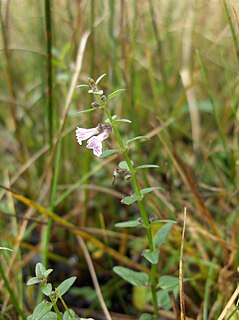
Scutellaria minor, the lesser skullcap, is a species of flowering plant in the family Lamiaceae.
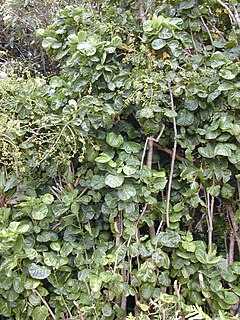
Polyscias scutellaria, the shield aralia, or plum aralia, is a tropical shrub or small tree reaching 2–6 meters tall. A native of the Southwest Pacific Islands, it's commonly grown in gardens.
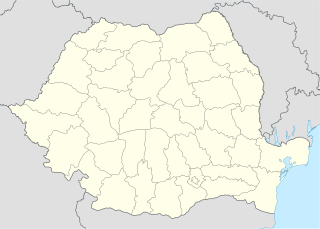
Cehei Pond Nature Reserve is situated in north-western Romania, in Crasna river floodplain, in Sălaj County and is a protected area with aquatic vegetation and fauna specific to such area.

Scutellaria parvula, commonly known as the small skullcap, is a member of the mint family. It is native to eastern and central North America, being most common in the central states and become rare in the east. It is found in areas that provide ample sunlight, such as prairies, glades, and savannas, often in calcareous soil. Flowering time is from late spring to early summer.














